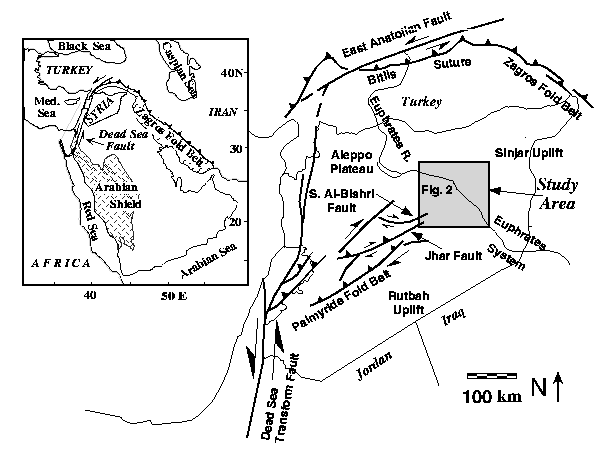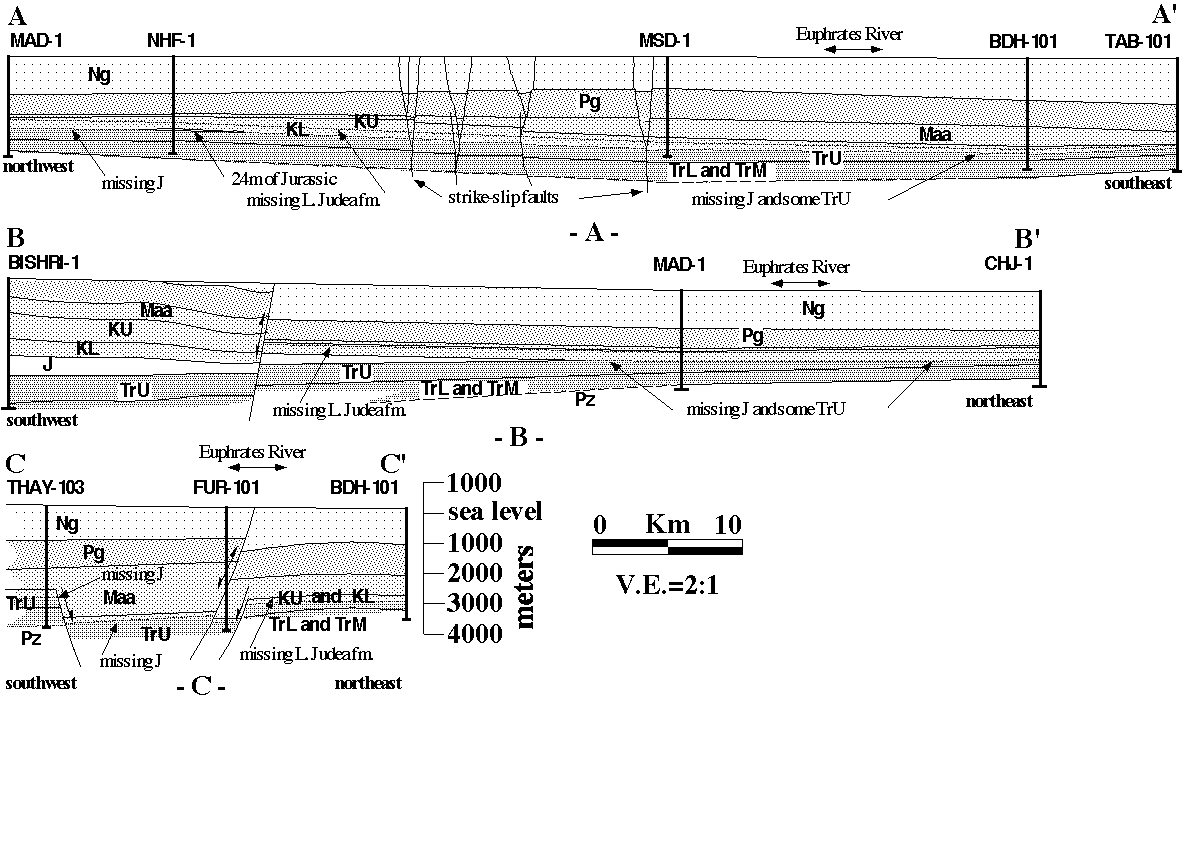Home | Results Summary | Publications | Participants | M.East / N.Africa Home
![]()
We interpret seismic data and well logs to indicate that the Euphrates graben, intersecting orthogonally with the Palmyride mountains, is an intraplate transtensional feature that probably developed in response to plate boundary stress created by a latest Cretaceous convergence event along the present-day northern boundary of the Arabian plate. The principal stress direction is proposed to lie generally parallel to the graben; hence, it may have formed as a tear in the Arabian crust while, as previously documented, the Palmyride region underwent shortening and uplift. Although Arabian plate boundary tectonism as well as shortening in the Palmyrides were periodically active during the entire Cenozoic, especially in Neogene and Quaternary time, the normal fault motions which formed the Euphrates graben were active within the study area only during the uppermost Cretaceous (Campanian-Maastrichtian). A broad, Cenozoic depression overlying the Euphrates graben and most of eastern Syria is possibly related to the Mesopotamian foredeep that developed in response to the nearby Zagros continental collision zone during Neogene and Quaternary time. Cenozoic strike slip faults lie between the graben and the Palmyrides and may kinematically separate the Palmyrides from the Euphrates system.
Figure 1. Left side: Map showing bounding faults and folds of the Arabian platform. Right side: location map of the intersection of the Euphrates depression with the Palmyride mountains.

Figure 2. Map of the study area showing seismic lines and well locations. Figure 1 shows the regional location of this map.

Figure 3. Well-to-well correlations in which the contacts, faults, and formation thicknesses are drawn following the structures interpreted from the seismic lines. Figure 2 shows map views of well locations and seismic lines. Ng are the Neogene formations of the Lower Fars through the Euphrates A, Pg are the Paleogene formations of the Chilou B through the Kermav, Maa is the Maastrichtian Shiranish formation which slightly overlaps part of the Campanian, KU are the Upper Cretaceous formations of the Soukhneh through the Judea, KL is the Lower Cretaceous Ghouna/Rutba formation, J is the Haramoun formation, TrU are the Upper Triassic formations of the Sarjelu through the Butma, TrM and TrL are the Middle and Lower Triassic formations of the Kurrachin Anhydrite through the Amanous Shale, and Pz is the Palaeozoic (Permian) Amanous formation. Only the major unconformities are drawn in Figure 3.

Figure 4. Maps showing time snapshots from Jurassic through Neogene of the intersection of the Palmyrides and Euphrates systems. See Figure 2 for well-to-well correlation (dashed lines). Seismic lines are represented by solid lines. (A) At the end of the Jurassic, erosion marked the Euphrates region while deposition was uninterrupted in the Bishri block of the Palmyrides. (B) Deposition began again in the Euphrates during the Early Cretaceous and generally continued throughout the Cretaceous, however, an unconformity occurred at the beginning of the Late Cretaceous. The formations thicken toward the Palmyrides (more deposition) from the Euphrates (less deposition). Normal faulting began during the Cretaceous. (C) A minor episode of shortening and uplift in the Palmyrides and a deep graben in the Euphrates developed simultaneously in the Maastrichtian of the latest Cretaceous. Normal faulting, from panel C, along the northeastern Palmyrides also probably continued. (D) The late Neogene marked uplift of the Palmyrides with Cretaceous normal faults reactivated as reverse faults; a broad depression developed in the Euphrates. Northeast-trending strike-slip faults generally separate the two areas.

Go back to Summary of Results
Go back to Cornell Syria Project Welcome Page